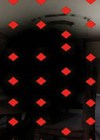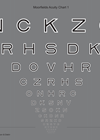For Oct/Nov 2021 we review a virtual reality (VR) solution for training and assessing pupil function. Different types of VR exist, and the application described here is used on the Oculus Quest or Pico headsets. The user wears a headset and holds controllers (Figure 1), allowing them to view and interact with the environment presented in the headset.

Figure 1: The Oculus Quest.
As the user moves, the view of the presented world reacts, and matches the movement. This type of headset has been available for several years but has only recently become a truly mainstream form of entertainment. Historically, VR headsets needed to be connected to a powerful computer. More recently (with the advent of the Oculus Quest), headsets have become available as standalone units. The Oculus headsets are currently the most popular on the consumer market. The devices are paired with handheld controllers, providing each hand with a thumb stick, buttons and triggers. Some applications and games work even without the controllers as cameras on the headset can detect the movement of the hands.
The pupil assessment software
This software is called the ‘Virtual Clinical Classroom’ and was designed by Dr Michael Williams, a Consultant Ophthalmologist based at Queen’s University of Belfast. The software development is the responsibility of the Sentireal company, also from Belfast.

Figure 2: Virtual Clinical Class Room.
The world presented to the user consists of a reception room and an adjacent examination room, where there is a simulated patient waiting for a pupil assessment (Figure 2). The user is equipped with a torch and a pencil (as a target for testing accommodation). After remembering to sanitise hands, dim the lights and greet the patient, they can use the tools to perform a pupil assessment, just like we would on a real patient.
Once the examination is completed, the user can interact with a clipboard on a nearby table. The user is presented with questions to determine the accuracy of their assessment and then given a score and breakdown of their performance. The user is then free to return to the reception room and reset the activity to have another go.
With each attempt, the software randomises the pathology being mimicked. On the student version, the user can pick from several pupillary findings, which include normal, random and fixed dilated pupil (with red eye or ptosis), afferent pupillary defect (APD) or relative afferent pupillary defect (RAPD). In addition to this student version, there is a similar ‘Institution’ version which allows an examiner to pre-set a particular abnormality for a particular candidate. That user can use a PIN to activate their particular assessment.
Quality of the simulation
After a few minutes of practice, I got used to the control mechanism and was able to perform a surprisingly realistic pupil assessment. This included direct and consensual assessment, in addition to swinging light test and accommodation. I did find myself getting closer to the eyes of the test subject and rechecking my findings. The pupil reactions are perfectly subtle and very closely reproduce the experience of assessing real pathology. Ptosis and eye movement deviation are also present when associated with the pupil abnormality (e.g., third nerve palsy). Even the accommodation response behaves in a very realistic way.
Versions, pricing and availability
There are two target audiences for this application. On one hand an individual student may wish to purchase the software for use on their own Oculus Quest 2 headset. Alternatively, an institution may choose to invest in headsets and this software for teaching and assessment. Those different requirements are best met by different VR headset solutions. The Oculus headsets are relatively inexpensive but do require a Facebook account to function (as Facebook owns the Oculus platform). This requirement makes their use in an institution difficult. The more powerful Pico headsets come at a higher cost and do not have the need for an associated Facebook account. To cater for both audience types, two versions of the application exist:
The student version
Platform: Oculus Quest range of devices
Cost: £40 from the Oculus ‘App Lab’
Link: https://bit.ly/VCCFull
Licence type: One-off app purchase
The institution version
Platform: Pico VR headset range
Cost: Depends on the number of users and headsets
Licence type: Annual licence
A free demo student version is available in the Oculus App Lab (https://bit.ly/VCCDemo), with a single pupil abnormality, allowing students to try the app.
This software (released in January 2021) is the first module of what the author hopes to expand into a full suite of virtual examination tools. As it is new to the market no studies or published articles yet exist. The author confirmed he is planning a study in the coming months and hopes that others will take up projects of their own. He (quite realistically I think) feels it is an untapped area, with lots of ‘low hanging fruit’ for those seeking medical education projects. A video and case study demonstrating the application is available for viewing here https://bit.ly/OphthaVCC
Contacts
Dr Williams can be contacted at m.williams@qub.ac.uk
Alternatively, Tom Houston (the CEO of the development company) can be contacted at tom.houston@sentireal.com
The author has no proprietary or financial interests in the products discussed.
COMMENTS ARE WELCOME








